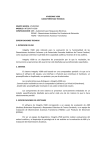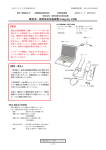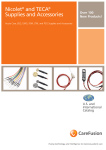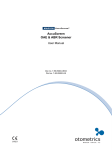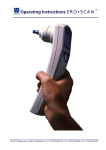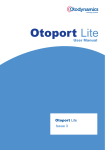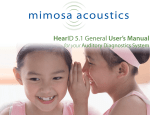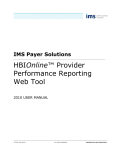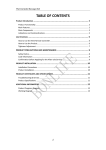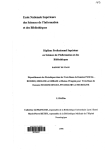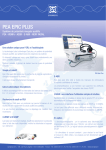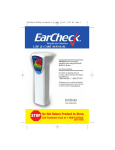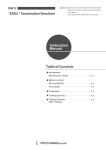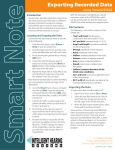Download VIVO - INTEG D_SHEET APR_17.qxd
Transcript
Integrity™ V500 Data Sheet Freedom • from sedation • from interferences • of mobility • in Audiology Product Overview Integrity™ Vivosonic Integrity™ V500 is the world’s only Wireless System for Auditory Electrophysiological Assessment and Hearing Screening. Constellation of new patented technologies makes clear ABR results attainable in virtually any patient of any age, and virtually any environment. These award-winning technologies include: in-situ amplification with the patented Amplitrode®, wireless communication with the VivoLink™, and digital Kalman-weighted filtering. Amplitrode® Amplitrode® is the world’s only patented in-situ bio-amplifier mounted directly on the electrode. In-situ amplification, i.e. “at the source,” reduces electric, magnetic, and RF field-induced noises. The result is a clean EEG signal in virtually any environment, including NICU, ICU, OR, doctors’ offices. To provide comfort and safety, Amplitrode® and its Clips have springs and release buttons for easy mounting and dismounting from the snap electrodes. VivoLink™ VivoLink™ is the world’s only wireless platform for Auditory Electrophysiological Assessment and Screening. It is batterypowered and controlled from a remote computer via wireless communication. Built-in microprocessor generates stimuli and analyzes responses. To ensure precision of stimuli generation and signal acquisition, VivoLink™ employs very high A/D and D/A Award-winning technology resolution and sampling rates. VivoLink™ is very convenient and comfortable to use with newborns, infants, young children, and adults. It can be secured on the adult’s chest with a lanyard; placed next to the baby in a crib, car seat, or stroller; worn by the baby’s caregiver; secured to the bed or incubator in the NICU; or conveniently placed in a toddler’s toy back-pack. Mobility makes testing comfortable and easy for both the patient and the clinician. Kalman-weighted Filtering Vivosonic’s patented algorithms (Kalman Filtering) optimize digital signal processing to dramatically reduce artifacts coming from muscular and ocular electrical activity, yielding clear responses in virtually any patient. It is ideal for testing non-sedated, nonsleeping, non-relaxed, and even active patients like feeding infants and playing children. Clinical benefits Integrity™ obviates sedation, with the associated risks and costs. Integrity™ makes it possible to test patients who are not candidates for sedation and to provide them with the care they need. This way, Integrity™ sets a new standard of patient care. Integrity™ V500 Data Sheet Specifications Intended use Integrity™ V500 is indicated for auditory evoked response testing as an aid in detecting hearing loss and lesions in the auditory pathway. Integrity™ V500 is a prescription device. The labeling, instructions and user operations are designed for trained professionals. System Portable PC-based, consisting of hardware and computer software, and configured in a carrying case. Software specifications Modules (test modalities) ABR B Auditory Brainstem Response (diagnostic and threshold) ASABR A Automated Screening ABR (Summer 2007) ECochG C Electrocochleography DPOAE D Distortion Product Otoacoustic Emission TEOAE T Transient Evoked Otoacoustic Emission ASSR S Auditory Steady State Response (late 2007) Computer software architecture (Graphic User Interface, GUI) Seven tab-selectable, common for all software modules (test modalities), user-friendly, and easy-to-navigate functional screens: Patients spreadsheet-style data entry, for patient demographic information Planner spreadsheet-style data entry, for scheduling appointments Protocol password-protected, for setting protocol parameters Test SQL-based, for running tests and on-line viewing results System for system settings and fully secure data backup, restore, and merging from multiple Integrity™ units Database SQL-based, secured, password-protected, spreadsheet-style data sorting and query, viewing and off-line analysis of test results, typing reports, printing results and reports, and exporting data to statistical software About Software identification and Customer Support information Module-specific specifications ABR – diagnostic and threshold estimation Stimulation: Air (AC) and bone conduction (BC), ipsi- and contralateral Stimuli: Click 100 µs and tone bursts 0.5, 1, 2, 3, and 4 kHz Calibration: dB pe SPL and dB nHL for AC, dB pe FL and dB nHL for BC Tone-burst windowing: Blackman, rectangular, and linear Stimulus rate: 7.1 to 95.0 per second with 0.1/s step Stimulus polarity: Condensation (C), Rarefaction (R), Alternating (C & R averaged), Alternating Split (C & R displayed separately) Recording traces: Average (A+B), buffers A and B, and difference (A-B) Recording window: From -1 to 0-30 ms Digital filters: Adjustable, high-pass 30-300 Hz and low-pass 1000-3000 Hz Measured variables: Real-time Wave I, II, III, IV, V latencies, I-III, III-V, I-V interpeak intervals, Wave I and V amplitudes, V/I amplitude ratio, and latency-specific Correlation Coefficient Latency norms: Newborn to adults (UCLA, Vanderbilt, and Boys Town) ASABR – automated screening ABR (Summer 2007) Stimulus: Air-conducted click 100 µs, 35 dB nHL, rate 37.7 per second Screening criteria: Statistic-based (variance ratio), not template-based ECochG Stimuli: Click 100 µs, 80-100 dB nHL (135 dB pe SPL) Recording: Gold-foiled ABR electrode (TipTrode™) Measured variables: Baseline, SP, and AP latencies and amplitudes, and SP/AP amplitude ratio TEOAE – diagnostic and automated screening Stimuli: Click 80 and 120 µs, 60-85 dB pe SPL, linear and non-linear Measured variables: Signal, noise, and SNR in 1-kHz, 1, 1/2, 1/4, 1/6-oct bands Pass-refer criteria: Multiple, flexible, user-selectable DPOAE – diagnostic and automated screening Stimuli: f2 frequencies 0.5, 0.75, 1, 1.5, 2, 2.5, 3, 3.2, 3.5, 4, 4.5, 5, 5.5, 6, 7, and 8 kHz; levels 40-75 dB SPL; f2/f1 ratio 1.2 and 1.22 (f2> f1) System Noise and System DP: ≤-10 dB SPL at 75/75 dB SPL stimulus Measured variables: Signal, noise, and SNR at f2 frequencies Pass-refer criteria: Multiple, flexible, user-selectable ASSR (late 2007) Stimuli: AM, FM, mixed AM and FM, single-ear and simultaneous R&L ears, single-frequency and multiple frequency modes, carrier frequencies 0.25, 0.5, 0.75, 1, 1.5, 2, 3, 4, 4.5, 6, and 8 kHz Hardware specifications VivoLink™ – wireless interface module Gain: User-selectable, 0, 10, 20, and 40 dB (post-Amplitrode®) Sampling rate: 38,400 samples per second (sps) A/D and D/A resolution: 24 bit Built-in: 1-cc Cavity for OAE Probe, 3 snaps for parking Amplitrode®, power switch, 3 LED indicators for power ON, impedance match, and wireless ON Notch filters: User-selectable 50 Hz, 60 Hz, or switched OFF Patient isolation: Radio-frequency, spread-spectrum wireless RF transmission: hopping, 2,402 to 2,480 MHz, emitted power <1.02 mW, connection range 30 feet (10 meters) Connectors: ER3-A (R&L) insert earphones, B-71 bone conductor, OAE Probe, Amplitrode® Physical: 0.8 lb (350g) weight, 7.2” (18cm) L x 3.65” (9.1cm) W x 1.2” (3cm) H Batteries: 4 AA NiMH (rechargeable) or Alkaline (non-rechargeable) Amplitrode® – electrode-mounted in-situ differential bio-amplifier Gain: 15,000 Frequency band: 30-3000 Hz Input impedance: 1.5 MΩ at 60Hz Noise level: 8 nV/root (Hz) at 100 Hz Common Mode Rejection Rate: ≥115 dB at 60 and 50 Hz Electrodes: Snap type, Neuroline 720 00-S or equivalent OAE Probe Design: Common for DPOAE and TEOAE, 2 microphones, 2 receivers Easy cleaning: Mini-brush, disinfecting wipes. No detachable parts. Configurations AEP Kit: Notebook computer with Integrity™ software, VivoLink™, Amplitrode®, ER-3A-ABR insert phones (10 Ω), B-71 bone conductor with calibration on CD-ROM, ER3-06 Eartip Adapter, starter ear tip set, starter Neuroline 720 00-S electrode set, disinfecting wipes, prep gel or pads, Bluetooth® dongle, ER-28S Cables and gold-foiled ear tips, Charger and 8 AA NiMH batteries, User’s Manual, carrying case OAE Kit: Notebook computer with Integrity™ software, VivoLink™, Probe with calibration on built-in EEPROM, Starter Ear Tip Set, disinfecting wipes, software, Bluetooth® dongle, Charger and 8 AA NiMH batteries, User’s Manual, carrying case Notebook computer: 15” screen, 1024x768 resolution, min 3 USB ports Optional devices: Printer, cart Warranty One year warranty on parts and labor. Extended warranty available Intellectual property U.S. Patent Nos. 6,463,411 and 6,778,955. Other patents pending in the US and other countries. Integrity and VivoLink are trademarks, and Amplitrode is a registered trade mark of Vivosonic Inc. Bluetooth is a registered trade mark of Bluetooth SIG Regulatory clearances Canada: Health Canada Medical Device Licence 67609. Industry Canada IC 6273A-V50 United States: FDA 510(k) K043396. FCC Part 15 Product ID TVZ-V50 European Union: CE Registration DE/CA09/0170/1207 to 1212, ETSI EN 300 328 V1.6.1 (2004-07) Reimbursement (US) CPT Coding: 92584 Electrocochleography 92585 Auditory evoked potentials for evoked response audiometry 92586 Limited auditory evoked potentials 92587 Evoked otoacoustic emissions; limited 92588 Evoked otoacoustic emissions, comprehensive or diagnostic evaluation ICD-9 Diagnoses Codes: 380.00-380.89 Disorders of the external ear 381.00-381.89 Nonsuppurative otitis media and Eustachian tube disorders 382.00-382.9 Suppurative and unspecified otitis media 383.00-383.9 Mastoiditis and related conditions 384.00-384.9 Other disorders of tympanic membrane 385.00-385.9 Other disorders of middle ear and mastoid 386.00-386.9 Vertiginous syndromes and other disorders of vestibular system 387.0-387.9 Otosclerosis 388.00-388.8 Other disorders of the ear 389.00-389.8 Hearing loss 780.4 Dizziness and giddiness Vivosonic Inc., 120-5525 Eglinton Ave West, Toronto, Ontario, Canada M9C 5K5 Toll-free 1.877.255.7685 Telephone +1.416.231.9997 Fax +1.416.231.2289 E-mail [email protected] www.vivosonic.com © Copyright Vivosonic Inc., 2007. All rights reserved. Document No. 11228, Rev. 1, 09-Apr-2007. Printed in Canada Integrity™ is designed and produced through a state-of-the-art Quality Management System certified to ISO 13485: 2003.





